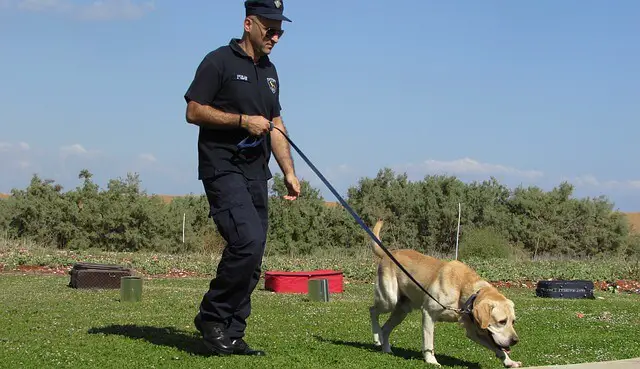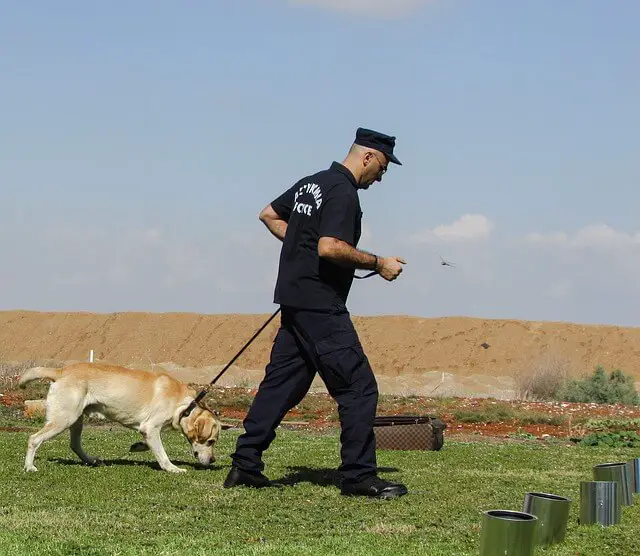How to Adopt a Service Dog That Failed
How Are Detection Dogs Trained
If you love dogs, you probably already know something about service dogs. There are different jobs service dogs can perform. Their unique skills make them suitable for a variety of police or military tasks. One of the most important (and coolest) jobs dogs can have is detection dogs. If you want to know more about how dogs help law enforcement with their fantastic sense of smell, here's what you should know about how detection dogs are trained.
What are detection dogs?
Before we go into detail about their training, we need to understand what detection dogs are. Detection dogs are dogs trained to uncover illegal substances, explosives, currency, blood, electronics, or wildlife scat. They will use their sensitive noses to help us prevent crimes. They're kind of like superheroes. Some detection dogs can even smell medical issues, like cancer.
There are two major jobs dogs specialize in - hunting and tracking. However, hunting dogs that can follow prey or tracking dogs law enforcement uses for finding missing persons are not considered detection dogs. The line gets hazy around cadaver dogs. Some call them detection dogs, and some disagree with that.
Why are dogs perfect for detection?
The obvious answer to this question is - dogs have a sense of smell that can be 10.000 - 100.000 times more sensitive than a human's sense of smell. Dogs can easily pick up scents of things they were trained to detect. Their nose is their most powerful weapon, and it is one of the main ways they examine their environment. Don't be surprised to see your dog has its nose close to the ground when you're walking them.

Besides their fantastic sense of smell, dogs and humans evolved to work together. We have lived and worked alongside each other for tens of thousands of years. They are "wired" in such a way that they want to please us. If you train a dog to detect something, they will try their hardest to find that substance and make their owners proud. That is just one of the things that make dogs so absolutely fantastic.
Which breeds are best at detection?
There are a few things we need to consider when picking the best dog breed for detection work. A breed's natural abilities should play a part. For example, a Bloodhound has the most powerful sense of smell in the canine kingdom. That breed has a clear advantage over, let's say, a Mastiff when it comes to detection work. Mastiffs are better protectors, and that is why they were bred in the first place.
The second thing that needs to be considered is a dog's character. Physical ability alone is not enough. Dogs need to be calm, motivated, and have a working mentality. Some breeds are simply better at that than others. For example, a Labrador doesn't have the most sensitive sense of smell, but they are highly trainable. They can be taught different things quickly, making them fantastic candidates for service dogs.
How are detection dogs trained?
Dogs might be born with the natural ability to detect scents we cannot pick, but these abilities need to be shaped and focused. A dog can be trained to detect different things, but many detection dogs specialize in finding one or two things. Keep in mind that drug-sniffing dogs need to detect different types of narcotics, which means learning up to 15 different scents. The same goes for dogs that detect explosives, currency, or other things that need to be detected.
Detection dog training
The detection dog training will require at least two types of training. The first one is obviously scent detection. The second part of the training will require obedience. The dog needs to be responsive to its handler's commands, and that response needs to be quick and accurate. Here's how a detection dog's training looks like;
Scent detection training
The scent detection training starts with getting a dog their favorite toy. In many cases, the trainer will get the dog used to playing with an odorless towel. The dog will constantly look for it and want to play with it. After a while, the trainer will start hiding narcotics inside the towel and hide it. The dog will have to search for it. After the dog finds the toy, they will be rewarded with the toy and a short playing session. This type of training will create an association in the dog's brain. The dog will associate the scent of narcotics with its favorite toy and rewards. The same training can be done with treats.
Obedience training
Getting a dog that can detect narcotics but is unwilling to follow commands is not that useful. That is precisely why all detection dogs need to have the obedience part of training . The dog will be taught to sit or bow after they come upon a suspicious scent. They will also be taught how to heel, search, sit, lie down, and recall. The training will be complete when the future detection dog can obey a command in 90% of cases.

Two types of approaches
One of the things detection dogs need to be trained in is the correct approach. There are two types of approaches - the passive and the aggressive. Here's the main difference.
Aggressive approach
Drug detection dogs are mostly taught the aggressive approach. When a detection dog comes across a scent of narcotics, it will start pawing or digging at the place where the scent comes from. If drugs are buried, the dog will start digging into the ground until the handler recalls them.
Passive approach
While the aggressive approach is used by drug-sniffing dogs, the passive approach is a lot better and safer option for dogs that detect explosives. You don't want to have a dog pawing or clawing an explosive device. Dogs will learn to pick up a scent, and when they do, they have to sit and notify the handler passively.
What can detection dogs detect?
Most of us know about drug-sniffing dogs or dogs that detect explosives. We already mentioned a few things dogs can be taught to detect. However, that only scratches the surface of what detection dogs can actually do. Here are some things dogs can be trained to detect;
- Human remains
- Endangered animal species
- Gourmet Fungi, such as Truffles
- Explosives
- Fire accelerants
- Bed bugs
- Cancer detection
- Drugs
- Firearms
- Ivory
- Currency
- SIM cards
- Mobile phones
- USB drives
- Mold
- Invasive species like quagga mussel
- Plants, animals, produce, and agricultural items that have to go through customs
- Termites
- Wildlife scat
There is a wide variety of detection jobs dogs perform for us. They are fantastic animals we use for companionship as well as work.
World Dog Finder team

How to Adopt a Service Dog That Failed
Source: https://worlddogfinder.com/blog/training/how-are-detection-dogs-trained